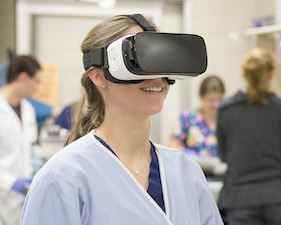Texas A&M College of Veterinary Medicine & Biomedical Science Develops First 360-degree Virtual Reality Video for Veterinary Education
COLLEGE STATION, Texas – Simply putting on a virtual reality (VR) headset can transport someone into an immersive digital environment. This technology has been used for both entertainment and educational purposes, including in medical schools, but for the first time is being leveraged in veterinary education. As part of the Texas A&M; College of Veterinary Medicine & Biomedical Sciences’ (CVM) commitment to transformational learning, the Center for Educational Technologies (CET) is beginning to apply the VR headset to veterinary medical education.


Collaborating with surgeons in the CVM’s Small Animal Hospital, the CET created a 360-degree video of a spay procedure. When a viewer wears a VR headset, that viewer is able to see the entire surgical suite by a simple movement of the head, as if present in the room.
“It’s the next step toward using VR as an educational medium for veterinary medicine,” said Dr. Jordan Tayce, instructional assistant professor in the CET. “The world’s first live-streamed virtual reality surgery was recently performed in human medicine. So, why not veterinary medicine too?”
This model has the potential to be an innovative and engaging way to teach VR experience that requires only a smartphone and a VR headset. “The cheapest VR headsets are less than $20,” Tayce said. “This is something that is accessible to anyone.”
“While there are many programs utilizing surgical videos to better prepare veterinary students for surgery, to our knowledge, this is the first use of VR in veterinary surgical training,” said Dr. Karen Cornell, associate dean for professional programs. “This VR-based experience allows the student to stand in the shoes of the surgeon performing the surgery and gain a perspective they don’t typically have until they have a scalpel blade in hand.”
“Imagine learning about a rare or complex surgery as if you’re right there at the operating table,” Tayce said. “We could create virtual environments to supplement student learning. We are only scratching the surface of possibilities.”


